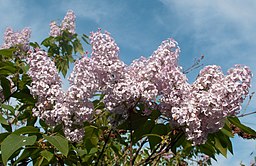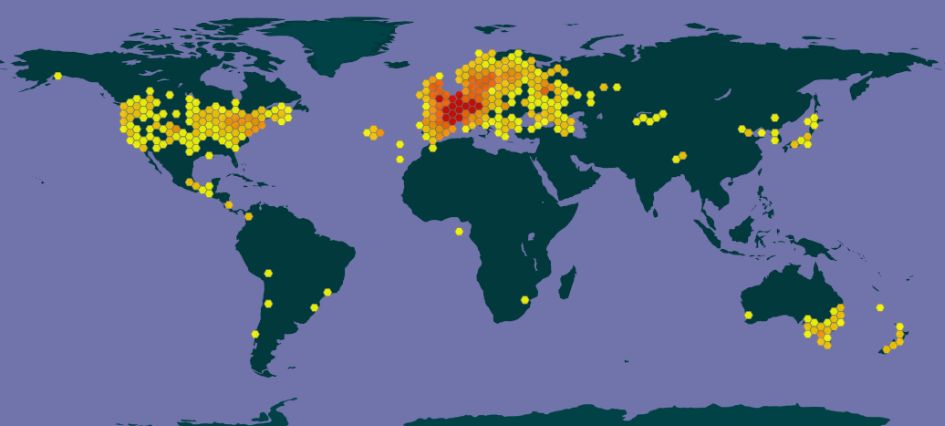 |
Common lilac | Status LU: established. 1st record: LU & ITW <1836. |
 |
Gewéinlechen Neelchesbam | Status Eur.: established. |
 |
Lilas commun | RA: ISEIA: C1. Harmonia+: 0,34. |
 |
Gemeiner Flieder | Wikipedia: |
 |
Sering | Back to the list of neophytes |
Contents
Report the species
→ Report Syringa vulgaris to the National Museum of Natural History.
Brief description
 The Common Lilac is widespread in southeastern Europe and the Near East. The original distribution ranges from central Albania to northern Romania. The species is frequently planted in numerous garden varieties and is often naturalised on rock slopes or railway embankments. It is a neophyte in some countries of Europe, Asia and North America. Light forests and bushes are preferred as habitats. The German Federal Agency for Nature Conservation considers the common lilac to be an invasive species and has placed it on the management list of the black list of invasive species, as it can displace native species (Wikipedia Contributors 2019).
The Common Lilac is widespread in southeastern Europe and the Near East. The original distribution ranges from central Albania to northern Romania. The species is frequently planted in numerous garden varieties and is often naturalised on rock slopes or railway embankments. It is a neophyte in some countries of Europe, Asia and North America. Light forests and bushes are preferred as habitats. The German Federal Agency for Nature Conservation considers the common lilac to be an invasive species and has placed it on the management list of the black list of invasive species, as it can displace native species (Wikipedia Contributors 2019).
Status and distribution in Luxembourg
Records of Syringa vulgaris L. in Luxembourg. Data source: Recorder-Lux, iNaturalist & GBIF, 2025-07-06.
The species, a very common garden shrub, was already reported in the wild in Luxembourg before 1836: according to Tinant (1836: 17) “This shrub […] is frequently found in the wild on the rocks of the Pétrus, Pulvermuhl, Bellevue etc.”1. Fischer (1872: 61) states the species, “frequently and commonly cultivated for ornamental purposes, is often found wild in hedges and on rocks near homes”. This is repeated by Krombach (1875: 219). To the known locations, Koltz (1873: 86) adds the ruins of the Grewchesberg between Greisch and Simmern.
The oldest herbarium specimen at the MNHNL was collected in May 1883 by Edmond Joseph Klein (1866-1942) from a cultivated shrub in Wiltz (Specimen № 16752, MNHNL 2000-). The next scientific record that we know of was made by Léopold Reichling on 8th July 1959 in Bierheck, Municipality of Steinsel (MNHNL 2000-). Currently, 59 records of Common Lilac are accessible through the MNHNL-mdata portal (MNHNL, iNaturalist & GBIF 2019).
Sometimes subspontaneous or naturalised (Lorr.): rock hedges, sunny slopes, wastelands (Lambinon & Verloove 2012: 537-538).
Other Syringa cultivars and taxa
- Syringa persica is grown in groves and gardens, and is sometimes found subspontaneously in hedges and near homes (Fischer 1872: 61).
- The lilacs are mainly grown from various cultivars of this species. Other ornamental Syringa species are also sometimes grown for ornamental purposes in parks and gardens (Lambinon & Verloove 2012: 537-538).
Risk assessment
ISEIA protocol
C1 (1+2+2+2) (Ries et al. 2013: 19).
Harmonia+ protocol
Overall risk score 0,34 = (Overall Invasion score 0,60 x Overall Impact score 0,57) (Ries et al. 2020).
 Invasion
Invasion0,57

 Impact
Impact0,34

 Risk
RiskWorldwide distribution
Bibliography
- Fischer, E., 1872. Les plantes subspontanées et naturalisées de la flore du grand-duché de Luxembourg. Publications de l’Institut royal grand-ducal de Luxembourg, section des sciences naturelles et mathématiques XII: 1-115. Imprimerie V. Buck, Luxembourg.
- GBIF, 2020. Syringa vulgaris L. in GBIF Secretariat (2019). GBIF Backbone Taxonomy. Checklist dataset https://doi.org/10.15468/39omei [accessed 2020-03-04]
- Koltz, J.-P.-J., 1873. Prodrome de la flore du grand-duché de Luxembourg. Première partie. Plantes phanérogames. Imprimerie V. Buck, Luxembourg. 279 S.
- Krombach, J.-H.-G., 1875. Flore du grand-duché de Luxembourg. Plantes phanérogames. 564 p. Luxembourg, Imprimerie Joris.
- Lambinon J. & F. Verloove, 2012. Nouvelle flore de la Belgique, du grand-duché de Luxembourg, du Nord de la France et des régions voisines. Sixième édition. Avec la collaboration de L. Delvosalle, B. Toussaint, D. Geerinck, I. Hoste, F. Van Rossum, B. Cornier, R. Schumacker, A. Vanderpoorten et H. Vannerom. Jardin botanique national de Belgique, Meise. CXXXIX + 1195 pp. ISBN : 9789072619884.
- MNHNL, 2000-. Syringa vulgaris in Recorder-Lux, database on the natural heritage of the Grand Duchy of Luxembourg. Musée national d’histoire naturelle, Luxembourg. URL: https://mdata.mnhn.lu [Accessed 2019-09-05]
- MNHNL, iNaturalist & GBIF, 2019. Syringa vulgaris L. in MNHNL-mdata, online portal combining species observation from Recorder-Lux, iNaturalist and GBIF. National Museum of Natural History, Luxembourg. URL: https://mdata.mnhn.lu [Accessed 2019-09-06]
- Ries, C. & Y. Krippel, 2021. First records of 56 invasive alien vascular plants in Luxembourg. Bulletin de la Société des naturalistes luxembourgeois 123: 115-127. [PDF 241 KB]
- Ries, C., Y. Krippel & M. Pfeiffenschneider, 2020. Risk assessment after the Harmonia+ protocol of invasive alien vascular plant species in Luxembourg. Bull. Soc. Nat. luxemb. 122: 197-205. [PDF 132 KB]
- Ries, C., Y. Krippel, M. Pfeiffenschneider & S. Schneider, 2013. Environmental impact assessment and black, watch and alert list classification after the ISEIA Protocol of non-native vascular plant species in Luxembourg. Bull. Soc. Nat. luxemb. 114: 15-21. [PDF 652 KB]
- Tinant, F. A., 1836. Flore luxembourgeoise, ou, Description des plantes phanérogames, recueillies et observées dans le grand-duché de Luxembourg, classées d’après le système sexuel de Linnée. 512 p. Luxembourg, J. P. Kuborn.
- Welter A., J.Turk & J. Trossen, 2008. Les arbres introduits au Luxembourg. Inventaire des essences arborescentes non indigènes de pleine terre présentes sur le territoire du Grand-Duché de Luxembourg. Ferrantia 53, Musée national d’histoire naturelle, Luxembourg, ISSN 1682-5519, 111 pp.
- Wikipedia Contributors, 2019. Gemeiner Flieder. In: Wikipedia, Die freie Enzyklopädie. URL: https://de.wikipedia.org/w/index.php?title=Gemeiner_Flieder&oldid=188437593 [accessed 2020-03-04]
Suggested citation of this webpage
Ries, C., M. Pfeiffenschneider & Y. Krippel (Eds.), 2025. Syringa vulgaris L. In: neobiota.lu - Invasive Alien Species in Luxembourg. National Museum of Natural History, Luxembourg. URL: https://neobiota.lu/syringa-vulgaris/ [Accessed 2025-07-06].
Page content last updated on 2021-03-12. Last proofread by Caroline Grounds on 2019-11-21.
- Original text: “Cet arbrisseau […] se retrouve fréquemment sauvage sur les rochers de la Pétrus, Pulvermuhl, Bellevue etc.” (Tinant 1836: 17)[↩]


